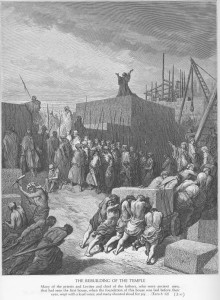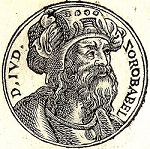 The Name Zerubbabel
The Name Zerubbabel
The name Zerubbabel is of Biblical origin, and is believed to mean “seed of Babylon”, or roughly “born in Babylon”. In Hebrew the name is זְרֻבָּבֶל; common variants on the name include Zorobabel (in Latin and in many New Testament translations), Zorovavel, or Ζοροβαβέλ (in Greek).1 It also happens to be my name, hence my interest in it! Pronunciations of the name vary, but I prefer zuh-ROO-buh-bell ([zəˈru bʌˌbɛl] in IPA).
The Historic Zerubbabel
The historic Zerubbabel was an Israelite who lived in Biblical times (generally around 550 to 500 BC), and who is mentioned several times in the Bible, in both the Old Testament (the Hebrew Bible) and the New Testament. Although his exact lineage is uncertain, he is known to be of the tribe of Judah, and was widely recognized to be of the Davidic (royal) lineage.
In the Hebrew Bible, he is most noted for leading the return of many Jews from Babylon to the Province of Judah, and for the rebuilding of the Temple at Jerusalem. In the Hebrew Bible, most references to Zerubbabel can be found in Ezra, Nehemiah, Haggai, and Zechariah.2
In the New Testament, he is included in the genealogy of Jesus, as a link between Jesus’ immediate ancestors and the Davidic line of kings. Historic references to Zerubbabel are limited to the Bible; there are some additional apocryphal references, but they are believed to be of a much later date, and are generally considered to be unreliable.3 Zerubbabel may also be the same person as a Sheshbazzar who is also mentioned in the Bible, though it is not perfectly clear that they are the same person.4
The Importance of Zerubbabel in Judaism
The primary importance of Zerubbabel as a historic figure is primarily in his connection to the Temple at Jerusalem, and it is this connection which is emphasized most in Biblical sources.
The Hebrew faith prior to the Babylonian captivity was centered first around the Tabernacle (a portable building the Israelites carried with them through the wilderness and into the land of Israel5), and then later around the Temple at Jerusalem built by Solomon.6 Both buildings figure prominently in the Old Testament as the centers of worship (see, e.g., Exodus 25 and 1 Kings 8).
When the Babylonians under Nebuchadnezzar conquered Israel, they destroyed the Temple at Jerusalem, and with it, the center of worship for the Jews. While the Jews continued to practice their faith while in captivity in Babylon, they did so without a center of worship, and without a clearly defined leadership.
That changed with the return of Jews from Babylon to the province of Judah, led by Ezra as the prophet and spiritual leader, Zerubbabel as the political leader, and Joshua the son of Jehozadak as High Priest, among others. With the support and authority of the Persians, and with encouragement from Ezra, Zerubbabel began the reconstruction of the Temple at Jerusalem, called the Second Temple (see the entry at Wikipedia).
The reconstruction of the Temple allowed for a more complete version of the Hebrew faith to be restored. While the practices of the faith may have shifted somewhat since the destruction of the First Temple, the restored faith was seen as the functional equivalent of the original. As such, Zerubbabel was seen as a critical agent in restoring the faith as it had been before the Babylonian conquest.
The Second Temple would eventually fall into disrepair, until it was restored and largely rebuilt under the rein of Herod the Great, just prior to the Christian era. The Temple of the Christian era is sometimes referred to as the Temple of Herod, but this is not quite correct, as it technically was still the Second Temple, only having undergone significant renovation. It was still standing during Jesus’ ministry, and as such is mentioned in many places in the New Testament, where it was clearly a center of worship for Jews and Christians (see, e.g., Mark 11:15-17 and Acts 2:46-47). It was totally destroyed by the Romans, however, in 70 CE during the Siege of Jerusalem, and was not rebuilt. Various Islamic shrines now stand on the Temple Mount in Jerusalem, with the Dome of the Rock standing where it is believed the First Temple and Second Temple once stood (see the entry at Wikipedia).
With the Temple once again destroyed, Judaism entered a period of crisis regarding its identity and the nature of worship. That crisis was largely resolved through a shift toward worship centered on the home and on the synagogue, with rabbis as the spiritual leaders of the Jewish people. Rabbinical Judaism as it is called remains the dominant form of Judaism in the modern era, but the influence of the Temple is still felt in Jewish thought.
Zerubbabel in Prophecy
It is in connection with his role in rebuilding the Temple that Zerubbabel is mentioned in a number of prophecies issued by the prophets of his era. While these relate directly to the rebuilding of the Temple (for instance, Haggai 1:1-11 and Zechariah 4:8-10), they can be more broadly read as referring to a future figure who will restore the proper way of worship for the Israelite people.
Zerubbabel is mentioned in the prophetic writings in connection with Joshua the son of Jehozadak, who was the High Priest at the time. Joshua is also mentioned in connection with an enigmatic figure called the Branch, who appears to be a Messianic figure, a future ruler who will restore the kingdom as it was previously (see Zechariah 6:9-15). This figure seems to have some traits in common with the historic Zerubbabel, specifically, that he will rebuild the Temple, and not just rebuild it, but rule in it. Zechariah’s prophecy regarding the Branch looked forward to a figure who would unite the roles of priest and king; thus, “he shall be a priest upon his throne”.
The Importance of Zerubbabel in Christianity
In light of the place of Zerubbabel in the history and prophesies of the Jews, it is important that he and his ancestors back to David are listed in the genealogy of Jesus (see Matthew 1:1-16 and Luke 3:23-38). While Jesus was widely recognized to be of the kingly lineage of Israel, it is important that his followers would emphasis that lineage in their accounts, which may have drawn attention to prophesies connected both to David and to Zerubbabel.
The prophesies of Zechariah, in particular, have connections to the accounts of Jesus given in the New Testament. Prophecies connected to the Branch included both direct references to Joshua the High Priest (note that the name “Jesus” is a Hellenized derivation of the name “Joshua”) and indirect references to Zerubbabel as the builder of the Temple. In the account given in the Gospels, Jesus directly assumed the role of a builder of temples, albeit in a deeper sense, as in John 2:18-22. Most significantly, Jesus’ declaration of his role as the builder of the temple was in response to a challenge to his authority. That connection – between the building of the temple and the kingly authority – can be found in the prophecy of Zechariah, which looked forward to the Messianic figure who would come and complete the work of restoring the faith that had begun with Joshua the son of Jehozadak and Zerubbabel.
Zerubbabel in Freemasonry
Zerubbabel is a prominent figure within the lore of freemasonry. His rebuilding of the Temple brings together two subjects of special interest to freemasons, architecture and religion, and he is directly connected to a subject of particular interest to freemasons, the Temple at Jerusalem. Consequently, Zerubbabel is often referenced in masonic lore, rites, and orders.
External Links
- Wikipedia: Zerubbabel
- Bible Hub: Zerubbabel
- Masonic Dictionary: Zerubbabel
- John C. Reeves at UNC Charlotte: Sefer Zerubbabel [Apocalypse of Zerubbabel]
References
- Wikipedia contributors, “Zerubbabel.” Wikipedia, The Free Encyclopedia. Wikipedia, The Free Encyclopedia, 16 Jul. 2013. Web. 11 Aug. 2013. http://en.wikipedia.org/wiki/Zerubbabel ↩
- See the Bible Hub entry under External Links for a comprehensive list of references to Zerubbabel in the Bible. ↩
- See, e.g., the Sefer Zerubbabel, under External Links. ↩
- For additional information on the history of Zerubbabel, see the Wikipedia entry (http://en.wikipedia.org/wiki/Zerubbabel). ↩
- Wikipedia contributors, “Tabernacle.” Wikipedia, The Free Encyclopedia. Wikipedia, The Free Encyclopedia, 29 Jul. 2013. Web. 12 Aug. 2013. http://en.wikipedia.org/wiki/Tabernacle ↩
- Wikipedia contributors. “Solomon’s Temple.” Wikipedia, The Free Encyclopedia. Wikipedia, The Free Encyclopedia, 10 Aug. 2013. Web. 12 Aug. 2013. http://en.wikipedia.org/wiki/First_Temple ↩
